= Ferocactus peninsulae f. brevispinus
a.k.a. "var. brevispina"
Accepted Scientific Name: Ferocactus peninsulae
Cactaceae (Britton & Rose) 3: 133, fig. 140. 1922 [12 Oct 1922]
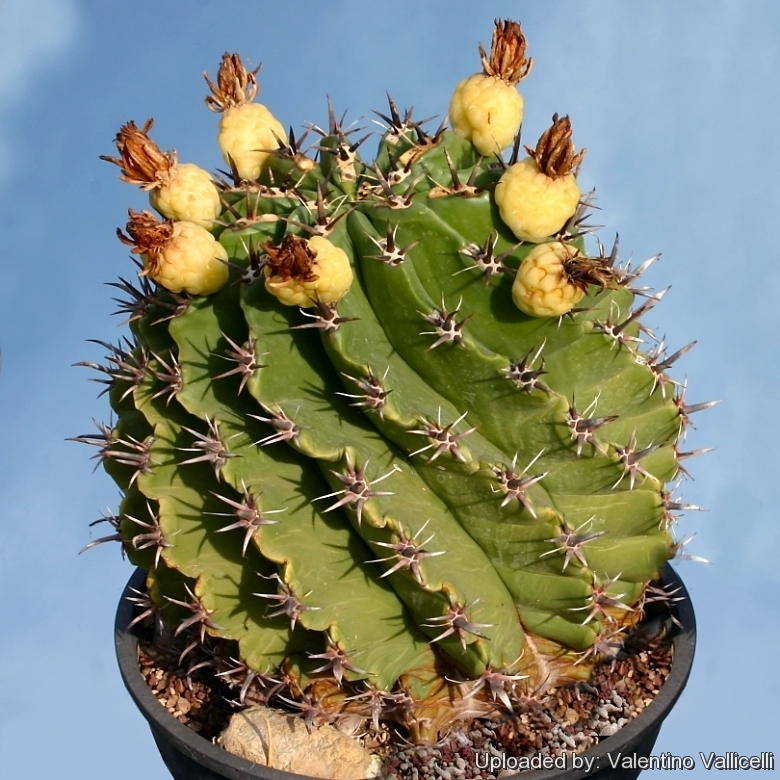
Ferocactus horridus f. brevispinus (Ferocactus peninsulae f. brevispinus) Photo by: Valentino Vallicelli
Origin and Habitat: F. horridus came from Mexico (Southern Baja California) but this short spined form is presumably of garden origin (Nursery selected form)
Habitat: Grows in grit on the hill-sides. It gets lots of water in two months and lots of sun all year.
Synonyms:
See all synonyms of Ferocactus peninsulae
Description: Ferocactus peninsulaeSN|11977]]SN|11977]] f. brevispinus is a solitary fast growing barrel ribbed cactus that differs from the type species in having a much shorter but stocky hooked central spine. This plant becomes very nice when a bit older.
Stem: Round to elongated dark green 25-40 cm in diameter 40-100 tall and attaining exceptionally a height of 2,5 metres, which is unusual for the genus.
Central spines: Has a very short but strong, recurving brownish-grey, large central spine. Slightly hooked or just with a slight kink at the end. Very dark red to almost black that can take a chalky colour ageing.
Radial spines: 7-10 short, straight but stout
Flower: Orange/Yellow and have orange or red midviens.
Fruits: Lemon yellow.
Seeds: Black, shining.
Subspecies, varieties, forms and cultivars of plants belonging to the Ferocactus peninsulae/wislizenii complex
This Taxon has various synonyms whit several controversial varieties and subspecies and comprises a multitude of different forms, but where each form is linked to others by populations of plants with intermediate characteristics:
 Ferocactus gracilis H.E.Gates: (subsp. gracilis) has stems up to 1 m in tall and has central spines less than 5 mm wide.Distribution: northern central Baja California.
Ferocactus gracilis H.E.Gates: (subsp. gracilis) has stems up to 1 m in tall and has central spines less than 5 mm wide.Distribution: northern central Baja California. Ferocactus gracilis subs. coloratus (H.E.Gates) N.P.Taylor: Usually less than 1 m tall but the widest central spines often exceed 5 mm. Distribution: south of subspecies gracilis.
Ferocactus gracilis subs. coloratus (H.E.Gates) N.P.Taylor: Usually less than 1 m tall but the widest central spines often exceed 5 mm. Distribution: south of subspecies gracilis. Ferocactus gracilis subs. gatesii (G.E.Linds.) N.P.Taylor: Up to 1,5 m tall, and the central spines are curved but not hooked and only 3 mm wide. Distribution: Bahia de los Angeles in the gulf of California (Smith Islands group in the Sea of Cortez)
Ferocactus gracilis subs. gatesii (G.E.Linds.) N.P.Taylor: Up to 1,5 m tall, and the central spines are curved but not hooked and only 3 mm wide. Distribution: Bahia de los Angeles in the gulf of California (Smith Islands group in the Sea of Cortez)- Ferocactus horridus Britton & Rose
 Ferocactus peninsulae (F.A.C.Weber) Britton & Rose: (subsp. peninsulae) has 4 central spines, forming a cross. Principal central spine flattened and strongly hooked, flowers over 5 cm long, outer periant segments spatulate. Plant somewhat allways taller than broad. Distribution: Baja California.
Ferocactus peninsulae (F.A.C.Weber) Britton & Rose: (subsp. peninsulae) has 4 central spines, forming a cross. Principal central spine flattened and strongly hooked, flowers over 5 cm long, outer periant segments spatulate. Plant somewhat allways taller than broad. Distribution: Baja California. Ferocactus peninsulae f. brevispinus (Chinned type): has very odd chinned ribs.
Ferocactus peninsulae f. brevispinus (Chinned type): has very odd chinned ribs. Ferocactus peninsulae f. brevispinus cristatus hort.: Crested form.
Ferocactus peninsulae f. brevispinus cristatus hort.: Crested form. Ferocactus peninsulae f. brevispinus hort.: short spined form.
Ferocactus peninsulae f. brevispinus hort.: short spined form. Ferocactus peninsulae f. brevispinus cv. Artichoke: spineless form remembering in shape an Obregonia denegrii.
Ferocactus peninsulae f. brevispinus cv. Artichoke: spineless form remembering in shape an Obregonia denegrii. Ferocactus peninsulae subs. santa-maria (Britton & Rose) Pilbeam & Bowdery: has yellow flowers, principal central spine straight or slightly curved. Plant somewhat conical, taller than broad. Distribution: Southern Baja California.
Ferocactus peninsulae subs. santa-maria (Britton & Rose) Pilbeam & Bowdery: has yellow flowers, principal central spine straight or slightly curved. Plant somewhat conical, taller than broad. Distribution: Southern Baja California. Ferocactus peninsulae subs. townsendianus (Britton & Rose) Pilbeam & Bowdery: has orange or red flowers, principal central spine strongly hooked. Plant somewhat conical, taller than broad. Distribution: Baja California (Magdalena Plain, Santa Margarita, Magdalena Islands).
Ferocactus peninsulae subs. townsendianus (Britton & Rose) Pilbeam & Bowdery: has orange or red flowers, principal central spine strongly hooked. Plant somewhat conical, taller than broad. Distribution: Baja California (Magdalena Plain, Santa Margarita, Magdalena Islands). Ferocactus peninsulae subs. viscainensis (H.E.Gates) F.Wolf & R.Wolf: has 4 central spines, forming a cross. Plant to 1,5 m tall and 3 dm wide. Ribs 13-21. Distribution: Baja california norte.
Ferocactus peninsulae subs. viscainensis (H.E.Gates) F.Wolf & R.Wolf: has 4 central spines, forming a cross. Plant to 1,5 m tall and 3 dm wide. Ribs 13-21. Distribution: Baja california norte.
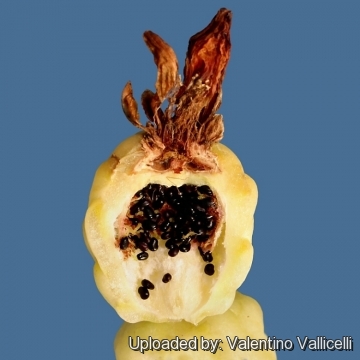 Ferocactus horridus f. brevispinus (Ferocactus peninsulae f. brevispinus) Photo by: Valentino Vallicelli
Ferocactus horridus f. brevispinus (Ferocactus peninsulae f. brevispinus) Photo by: Valentino Vallicelli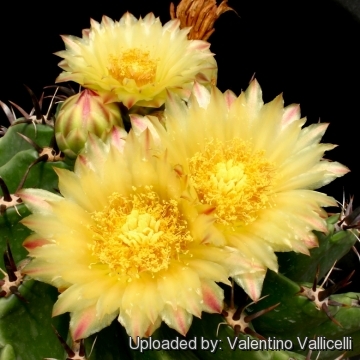 Ferocactus horridus f. brevispinus (Ferocactus peninsulae f. brevispinus) Photo by: Valentino Vallicelli
Ferocactus horridus f. brevispinus (Ferocactus peninsulae f. brevispinus) Photo by: Valentino Vallicelli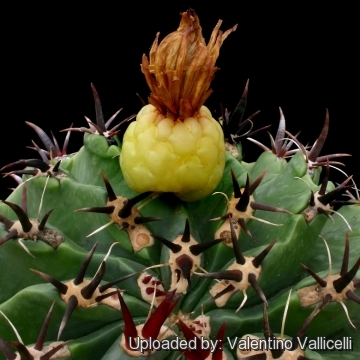 Ferocactus horridus f. brevispinus (Ferocactus peninsulae f. brevispinus) Photo by: Valentino Vallicelli
Ferocactus horridus f. brevispinus (Ferocactus peninsulae f. brevispinus) Photo by: Valentino Vallicelli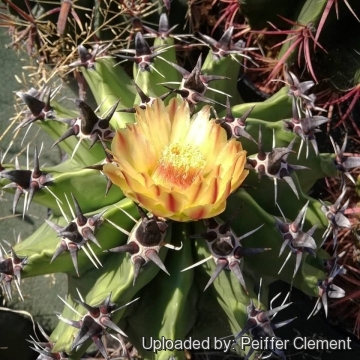 Ferocactus horridus f. brevispinus (Ferocactus peninsulae f. brevispinus) Photo by: Peiffer Clement
Ferocactus horridus f. brevispinus (Ferocactus peninsulae f. brevispinus) Photo by: Peiffer Clement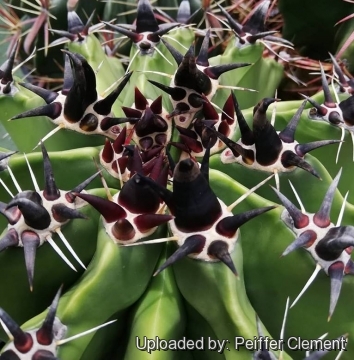 Ferocactus horridus f. brevispinus (Ferocactus peninsulae f. brevispinus) Photo by: Peiffer Clement
Ferocactus horridus f. brevispinus (Ferocactus peninsulae f. brevispinus) Photo by: Peiffer Clement Ferocactus horridus f. brevispinus (Ferocactus peninsulae f. brevispinus) Photo by: Valentino Vallicelli
Ferocactus horridus f. brevispinus (Ferocactus peninsulae f. brevispinus) Photo by: Valentino VallicelliCultivation and Propagation: It is a summer-growing and pretty easy species thought slow to start. It is suited for any rich, well drained soil such us clay, pumice, lava grit, and only a little peat or leaf-mould. If potted, repot preferably in the spring, if their roots become cramped. Generally, they should be repotted every other year in order to provide fresh soil. However, this doesn't necessarily mean they'll need larger containers. Fill about a quarter of the pot with broken crocks, gravel, etc. to promote good drainage. After repotting, do not water for a week or more. Water regularly during the aestival growth cycle (this plant need plenty of water, but do not overwater and let their soil dry out between waterings), and also needs to be avoided wetting the body of this plant while it is in sunlight. A wet cactus in the sun light can cause sun burning which can lead to scars or even fungal infections and death, keep rather dry in winter. No water should ever be allowed to stand around the roots. Feed with a high potassium fertilizer in summer.
Exposure: Outside they need a bright exposure, full sun or half shade in summer if the location is exceedingly hot or bright, inside needs bright light, and some direct sun. It can tolerate moderate shade, and a plant that has been growing in shade should be slowly hardened off before placing it in full sun as the plant will be severely scorched if moved too suddenly from shade into sun.
Frost Tolerance: Light frost protection required for safe cultivation, but can tolerate sporadic light frost. This plants need a period of cool rest in winter to produce flowers abundantly.
Diseases and pests: Watch for infestations of mealybug, scale insects and spider mite.
Plant in good conditions will start to bloom when reach the diameter of only 15-18 cm.
Propagation: Seeds are the only way of reproducing.
















